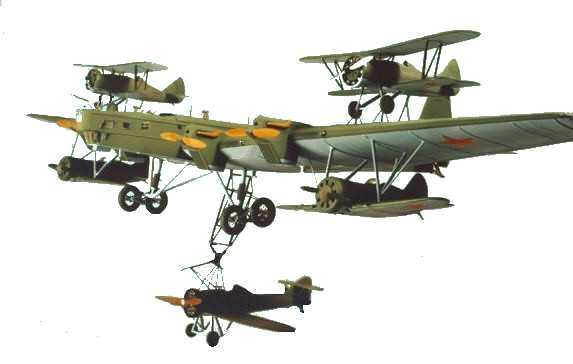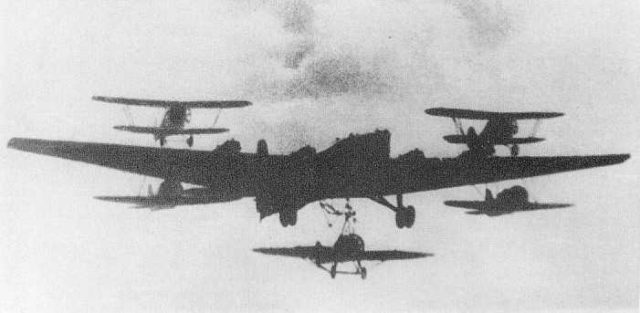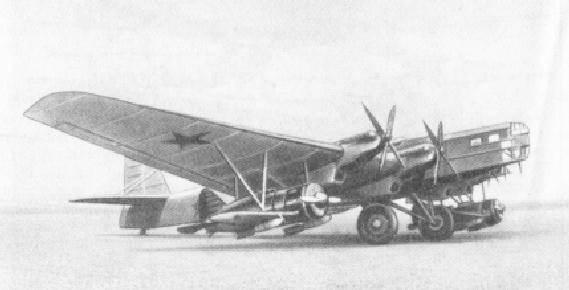Vladimir Sergeyevich Vakhmistrov, of the Russian Airforce’s scientific test institute, started work in June 1931 on combinations of fighters rigidly attached to heavy bomber aircraft. The system was envisioned to serve several purposes:
- Delivery of fighters beyond their conventional range
- Provision of bombers with escort fighters
- Use of fighters for dive bombing with heavier bombs than they would be able to take off with on their own
- Using the added thrust of parasite aircraft to get a heavily-laden bomber airborne.

The Zveno bomber/fighter designed, by Vakhmistrov, must surely be one of the strangest and most bizarre looking aircraft that ever took flight. The concept of the Zveno first took shape in the mid-1920s, when the Soviet Air Force was looking to both strike against troops on the battlefield and shoot down enemy bombers.
The Zveno design finally took root in the 1930s with a parasite aircraft model consisting of a Tupelov TB-1 or a Tupelov TB-3 heavy bomber and acting as the “mothership” for between 2-5 fighters.
Depending on the variation of the Zveno, it either launched fighters from the “mothership” or docked in flight and could refuel from the bomber. During the opening of the German-Soviet War, the Zveno-SPB, using a TB-3 and two Polikarpov I-16s armed with two 550lb bombs, was used operationally with good results against certain targets.
All of the parasite aircraft were always piloted and had all their engines running, as it was expected that the combined thrust of the engines would more than offset the heaviness and improve the performance of the “mother-ship” compared to conventional bombers.
The bombers were attached rigidly with a pyramid-shaped metal frames with bomb latches that the pilots could control (on Zveno-1, the front latches were controlled by the bomber crew, while the back latch was controlled by the pilot, this was changed to all-pilot control in the next version). On the original design, it included umbilical lines for the fuel that allowed the fighters to use fuel from the bomber while attached, even though this was not always done in practice.
On December 3rd, 1931, the first successful flight of Zveno-1 that used a Tupolev TB-1 “mother-ship” and two Tupolev I-4 fighters mounted on top of the wings.
The presence of docked fighters had nearly no impact on the performance of the “mother-ship”; Zveno-2 Tupolev TB-3 carried three Polikarpov I-5 fighters and handled the same as an ordinary bomber.
The centerline aircraft had to be lifted by hand on to the top of the fuselage in-order-to mount the wings, which had to be pushed up special ramps. Because this was such a large job to be done by hand, the centerline I-5 became a permanent fixture on top of the Zveno-2 TB-3 and never started in the air.
The Zveno-3, that carried two Grigorovich I-Z fighters under the wings, presented a different challenge—the I-Z was a monoplane with fixed landing gear that touched the ground while it was suspended under the “mother-ship”. To make takeoff easier on the uneven ground, the fighters were attached to a floating frame that allowed vertical movement relative to the TB-3. It was during one of these test flights that I-Z pilot Korotkov incorrectly timed the locking
It was during one of these test flights that I-Z pilot Korotkov incorrectly timed the locking maneuver and the lift generated by his aircraft broke the docking frame and crashed him into the wing of the “mother-ship”. Korotkov was killed when the aircraft came in for an emergency landing with both fighters still attached.


This accident was the most serious of all the Zveno program, despite the inherent complexity of carrying up to five aircraft, performing mid-air launching and dockings.
Tests using different combinations of aircraft determined that the top-mounted configurations presented the most difficult results in docking due to the turbulent airflow coming off the mothership’s wings. They solved the issue with the safe underwing attachment when the Polikarpov I-16 fighter showed up with its retractable landing gear. This allowed for the use of the same rigid mounting frames that the top-mounted aircraft used.

The definitive version of Vakhmistrov “Zveno” project is the “SPB” (also known as “Zveno-SPB”). “SPB” stands for Sostavnoi Pikiruyuschiy Bombardirovschik – “composite dive bomber”: the parasite I-16s were used as dive bombers; they carried two 100-kg or even 250-kg bombs.
Here is another bomber story from us: The ‘Goblin’ XF-85: the strange “Parasite Bomber” of WWII
The combination was tested successfully in July 1937 and was officially approved for service in 1938. The first production model was made by Zavod No.207 in June 1940. Five SPB combinations were introduced by the 2nd Special Squadron of 32nd Fighter Air Regiment (IAP), 62nd Air Brigade of Black Sea Naval Air Force based in Yevpatoria and commanded by Arseny Shubikov (therefore the squadron was nicknamed “Shubikov circus”).
Two Zveno-SPB planes made a successful attack on the Constanta Oil Depot on July 26th, 1941, in broad daylight, with no losses. The aircraft disconnected 25 miles away from the depot and returned home under their own power.
